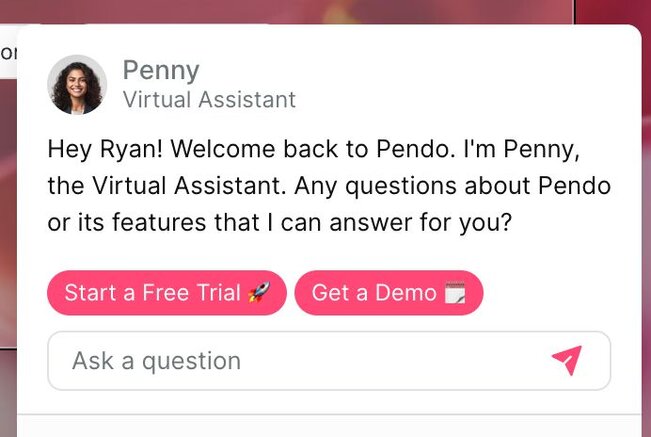Prospects expect real-time answers, personalized interactions, and seamless experiences from the very first touchpoint.
We felt this shift firsthand at Pendo, which is why we moved from a traditional SaaS chatbot to an agentic-first chatbot. (We loved her so much, we named her Penny.)
The results of this shift have been nothing short of transformative—for our buyers, our sales team, and our pipeline.
Goodbye static chatbots, hello dynamic AI agents
Like many companies, we once relied on a traditional website chatbot. Our team had to manually script every possible question and answer that end-users might ask. As you can imagine, this was incredibly resource-intensive, clunky, and didn’t deliver the results we needed.
At the same time, we have a terrific partnership with our SDR team. But even the best SDRs, with the best processes, can’t outrun the clock.
Traditional lead follow-up is simply too slow in today’s competitive landscape. When a prospect raises their hand and tells us, “I want to learn more about Pendo,” but then has to wait hours (or days) to set up a call, chances are they’ll go check out a competitor.
Speed to value is king, and that’s exactly where agents should step in.
Speeding up sales cycles with AI SDRs
By introducing Penny as our AI SDR to Pendo’s GTM team, we redesigned (and sped up) how potential customers can find and engage with Pendo.
Instead of letting SDRs respond to every inbound request (like triaging, qualifying, and following up with prospects), Penny instantly handles that first touch. It greets visitors, answers questions, qualifies them in real time, and can either book a meeting or connect them directly with the right person.

This shift freed our human SDRs to focus on what they do best: building trust, creating relationships, and having more nuanced, complex conversations that move deals forward. Together, we’re creating a smoother buyer’s journey and spending time far more efficiently.
A 400% increase in meetings booked
Since replacing our static chatbot with an agentic one, our meeting-to-pipeline conversion rate is the highest it’s ever been. We’ve seen a ~400% increase in meetings booked through the chat channel—and while we love this metric, the quality of these meetings has also improved.
Penny helps prospects learn more about Pendo before calls by asking questions, exploring relevant resources, and conducting research. That means our SDRs and AEs spend less time on the basics and more time digging into specifics.
Meetings are more productive, sales cycles are faster, and pipeline is higher. Win-win-win.
How to build your own agentic workflows
For organizations considering a move to agentic workflows, here are a few lessons we’ve learned:
- Take time to audit and map your workflows. Before you deploy an agent, you need to know which workflow you want to automate. An agent is only as good as the context and goals you give it. Pendo helps companies map workflows, identify friction, and pinpoint where an agent can add value.
- Measure and optimize these workflows. A recent MIT report revealed that 95% of AI pilots fail to produce measurable outcomes. What success looks like, measure it against, and keep iterating. With Pendo Agent Analytics, we can track the speed, time to completion, and conversions of these workflows, ensuring they add as much value as possible.
At Pendo, we’ve seen firsthand how agentic workflows accelerate the buyer journey and empower humans to focus where they shine.
Learn more about measuring and improving agentic workflows with Pendo Agent Analytics. Or, take a tour to test it out.
![[object Object]](https://cdn.builder.io/api/v1/image/assets%2F6a96e08774184353b3aa88032e406411%2F16b6f2565d1d4a5585db322386f9be7f?format=webp)
![[object Object]](https://cdn.builder.io/api/v1/image/assets%2F6a96e08774184353b3aa88032e406411%2F728d67faa5f64299b8f8f0b138881fb5?format=webp)
![[object Object]](https://cdn.builder.io/api/v1/image/assets%2F6a96e08774184353b3aa88032e406411%2Fc08c4160a2724c4fa3d365eb43791b09?format=webp)

